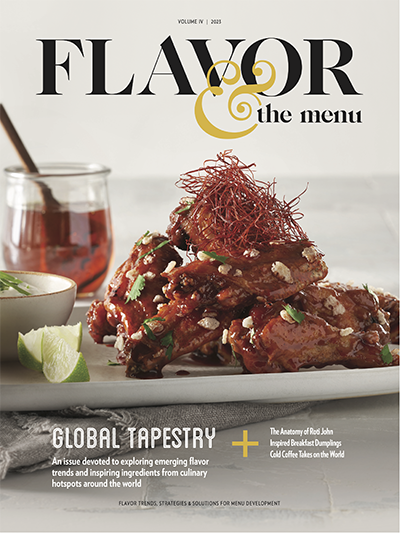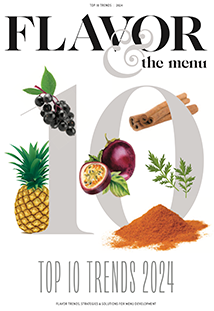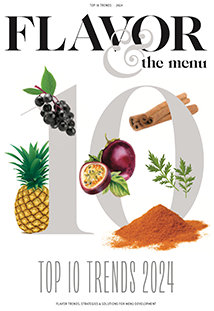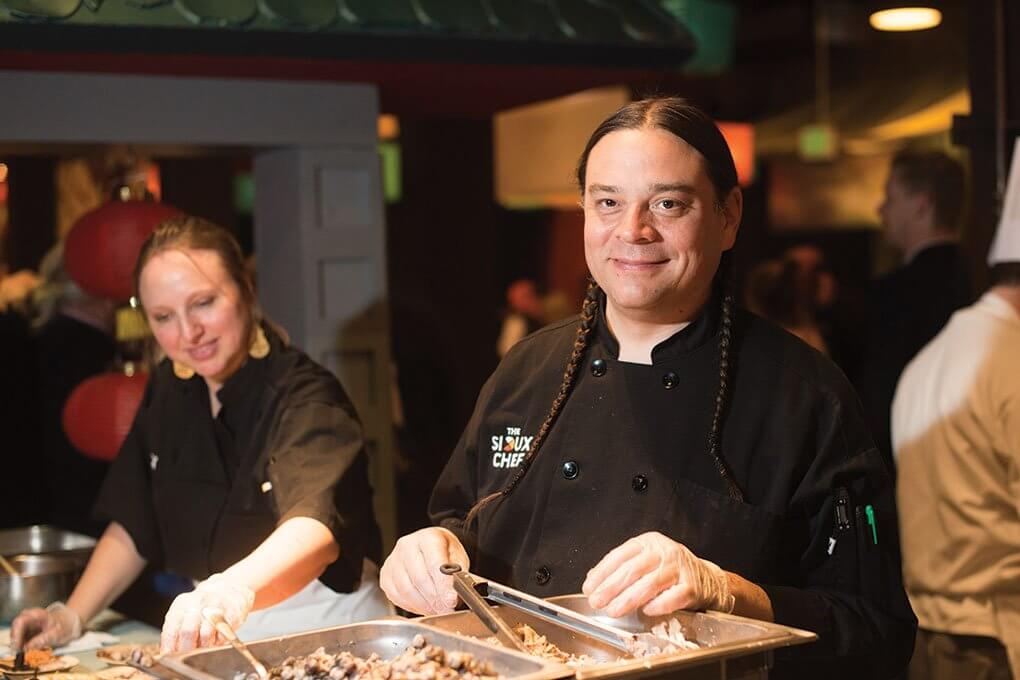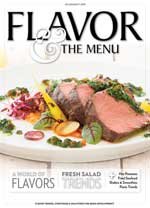A synopsis of the American dining scene in 1998: The country was in the midst of an economic boom that had driven the growth of huge full-service restaurant chains, where hungry Baby Boomers were happy to spend their dining dollars. A segment known as “fast casual” was in its infancy. Farm-to-table dining was little-known and confined to the coasts. Small plates were primarily served in Spanish tapas bars. French cuisine still dominated the fine-dining segment, and foie gras was beginning to capture the imagination of chefs nationwide. The “upstreaming” trend, where upscale food ingredients began migrating onto the menus of mainstream casual restaurants, was just gaining momentum. And in New York City, the Chelsea Market Food Hall celebrated its first anniversary. There were no pop-up restaurants, food-truck festivals, gastropubs, craft cocktails, nose-to-tail restaurants or Korean tacos.
It was also in 1998 that The Culinary Institute of America (CIA) staged its first Worlds of Flavor International Conference & Festival at its three-year-old Greystone campus in St. Helena, Calif., bringing together expert chefs from the United States and around the globe to provide their insights into a particular cuisine or culinary theme. Via oral presentations, cooking demonstrations and live tastings, these chefs reached an audience of foodservice professionals that included restaurant owners, food and beverage managers, corporate chefs and culinary educators.
To mark its twentieth anniversary, the CIA chose the theme “Legends of Flavor” for the 2018 conference, bringing back many of the chefs from past conferences whose cooking has influenced the evolution of foods and flavors on American menus, along with an assemblage of young, upcoming chefs who are charting their own unique culinary directions.
And for attendees seeking new or lesser-known ingredients that could be used to innovate mainstream menus, the conference did not disappoint.
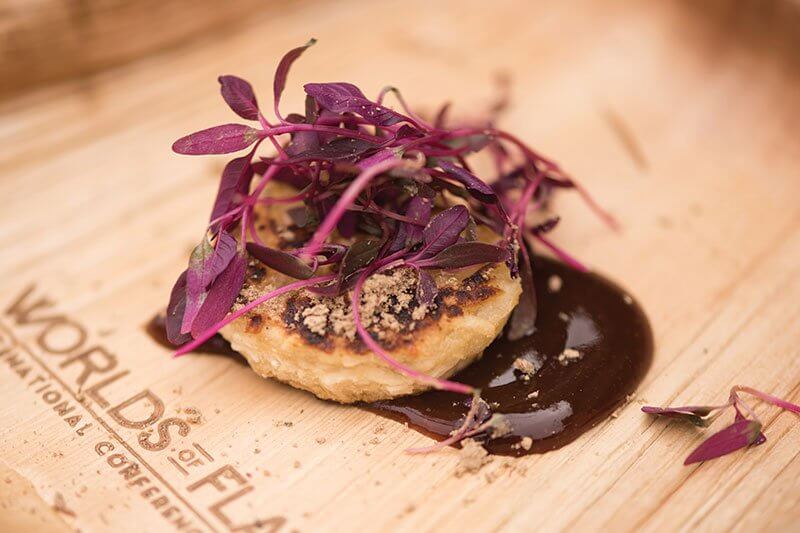
Yuca and cattails are among the indigenous ingredients used by Chef Sean Sherman
Africa: the Next Frontier
A cadre of chefs representing the cuisines of Central, West and North Africa presented the most leading-edge demonstrations of the conference, highlighting ingredients and dishes likely unfamiliar to all but the most experienced world traveler.
The variety of flavors and textures in the dishes that were demonstrated and sampled was striking—some rich and indulgent, some spicily exotic, others simply comforting—but all prompted many of the attendees to begin discussing ways that these foods and flavors could be incorporated into today’s menus.
Jeremy Chan, executive chef and co-founder of Ikoyi in London, focuses on the indigenous ingredients of West African cuisine. He served grilled octopus atop Ndolé, a classic green stew of West African bitter leaf and peanut purée simmered with chopped beef, shrimp and dried seafood powder. The combination of umami-rich ingredients resulted in levels of craveability and complexity unexpected in a slowly simmered stew.
Also based in London, Zoe Adjonyoh, chef/owner of Zoe’s Ghana Kitchen, demonstrated a signature dish: a whole Pan-Fried Tilapia basted with baobab butter, a mixture of whole butter and the tartly flavored powder of dried baobab fruit, garnished with kpakpo (pah-pow) shito salsa, a blend of tiny green Ghanaian hot peppers mashed with tomatoes, onion and salt.
Bambara Groundnut
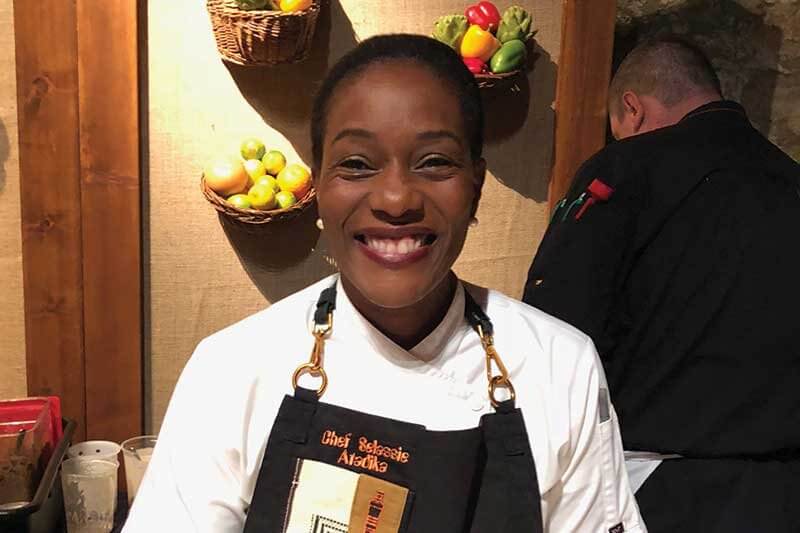
Chef Selassie Atadika of Ghana showed how bambara groundnut can take many flavorful forms.
Selassie Atadika, the chef behind the nomadic dining concept Midunu, in Ghana, presented a compelling profile of the bambara groundnut, a prolific, versatile and nutritious legume indigenous to West Africa.
Atadika praised this groundnut for its ability to thrive in semi-arid climates and low fertility soils, and its status as a “complete food,” rich in carbohydrates with relatively high amounts of protein, fat and essential amino acids. While most often served simply boiled, it is also dried and ground into flour, and processed to yield high-quality nut milk. In the hands of a chef, the bambara groundnut may be transformed into a variety of craveable savory and sweet dishes.
Atadika described it as “the African version of a chickpea.” It was only natural, then, that she served a hummus based on the groundnut in an elaborate “textural study” dish. It included the hummus garnished with crunchy bits of toasted bambara crumbs, boiled bambara, and a steamed bambara flour-based terrine known as tubani, dressed with shallot-seasoned shea butter and a sobolo (hibiscus tea) mignonette.
Highlighting this groundnut’s potential in sweet applications, Atadika served her signature dish, Kofi Rich Man, which layers Liberian rice bread with roasted bambara groundnut and plantains, topped with ginger crème anglaise and toasted bambara groundnut crumble.
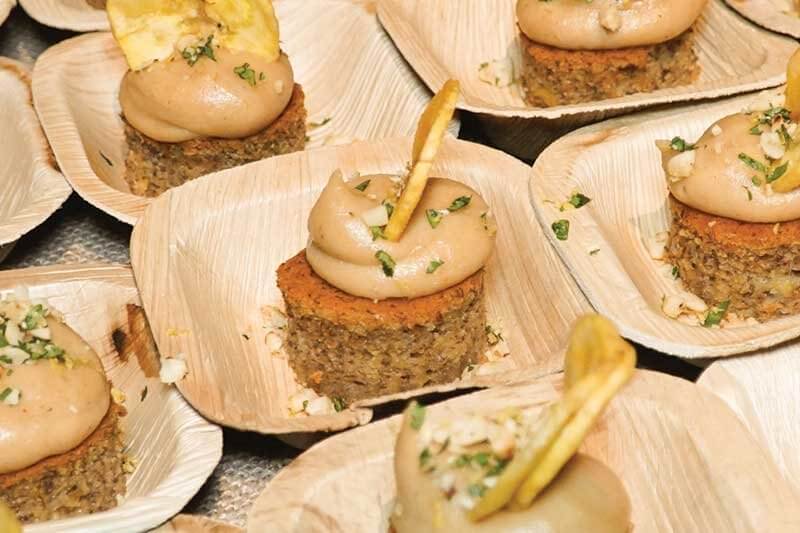
Kofi Rich Man from Selassie Atadika
The Supergrain of Central Africa
Senegalese chef Pierre Thiam, based in New York, spoke passionately of the African ancient grain fonio, which grows in abundance throughout Central Africa. The smallest member of the millet family, fonio has the potential to nourish the growing population of Central Africa, which Thiam said is set to double by 2050. The plant grows to maturity in just two months, thrives in dry climates and is drought resistant. He also touted its nutritional profile; it is gluten-free and low glycemic, with an abundance of amino acids and several key vitamins.
Thiam was most passionate, however, about fonio’s taste and texture, serving a Fonio Mango Salad, tossing the tiny grains with grape tomatoes, garlic, ginger, mint, lemon and a touch of hot pepper. His Lamb Fonio Tabouleh featured shreds of tender lamb with cucumber, diced olives, microgreens and a mustard-citrus dressing.
Cooked fonio resembles what could best be described as a “micro-couscous,” the grains being about half the size of bulgur, which lent these dishes a notably delicate texture and mouthfeel.
One Dish, Endless Variations
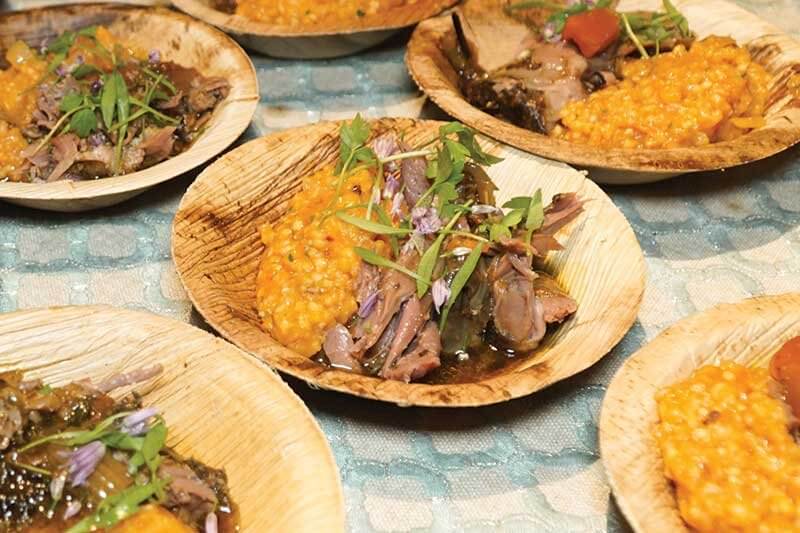 Gerry Ludwig
Gerry Ludwig Jollof Rice Grits with Braised Lamb and Roasted Pumpkin Seeds from Shola Olunloyo
A classic dish of West Africa, jollof rice was served in at least a half-dozen variations at the conference. Resembling Spanish rice at first glance, jollof rice surprises the palate with complex flavor layers and more than a bit of heat. The traditional preparation involves cooking the rice in a purée of tomatoes, onion, fresh hot peppers, dried chiles, ginger, curry powder, and thyme that has first been fried in oil.
From there the improvisation begins, although not in any random or haphazard fashion, as the art of creating a signature jollof is something West Africans take seriously and personally.
Kwame Onwuachi, executive chef and creator behind Kith/Kin in Washington, D.C., received raves for his Jollof Rice and Nigerian Red Stew simmered with duck confit.
Chef Joseph “JJ” Johnson, based in New York, served a dish of Curried Eggplant over a griddled cake of Jollof Sticky Rice.
The Jollof Rice Grits from Shola Olunloyo, chef and founder of StudioKitchen in Philadelphia, was made by rinsing and pounding broken rice before simmering, resulting in a luxuriously creamy texture.
And Selassie Atadika switched out rice in favor of gari, which is granulated cassava flour, for her dish of Gari Jollof that she stuffed into cured sardines.
Clearly, these regional African cuisines present numerous opportunities for chefs to expand their repertoires and be first-to-market with a set of largely undiscovered global flavors.
From Taro to Tucupi
Several other international chefs highlighted lesser-known ingredients that are of significant importance to their traditional cuisines.
Monique Fiso—chef with the pop-up dining series Hiakai in New Zealand, specializing in the cuisine of her Maori ancestry—prepared a traditional dish of Duck in Taro Leaf, braising and shredding duck-leg meat that she then wrapped in layers of taro leaf and steamed, serving the stuffed leaves in a coconut-cream reduction based on the braising liquid.
Manoella Buffara, chef/owner of restaurant Manu in Curitiba, Brazil, focuses her menu on the indigenous ingredients of the Paraná region of Southern Brazil, where her family has lived for generations. Her guiding principles center on intense pride in her roots, family and culture. Buffara demonstrated a dish of Crab and Coconut in Tucupi, a sauce she says is “at the heart of Pará cuisine.” Tucupi is made from the juice of the manioc root, which must be intensely boiled to make it safe to consume, as the raw juice contains traces of cyanide. The sauce has a tart and slightly citrusy flavor, which Buffara says marries well with a wide variety of Brazilian meats, poultry and seafood, and also serves as a base for traditional soups.
Worldly Mash-Ups
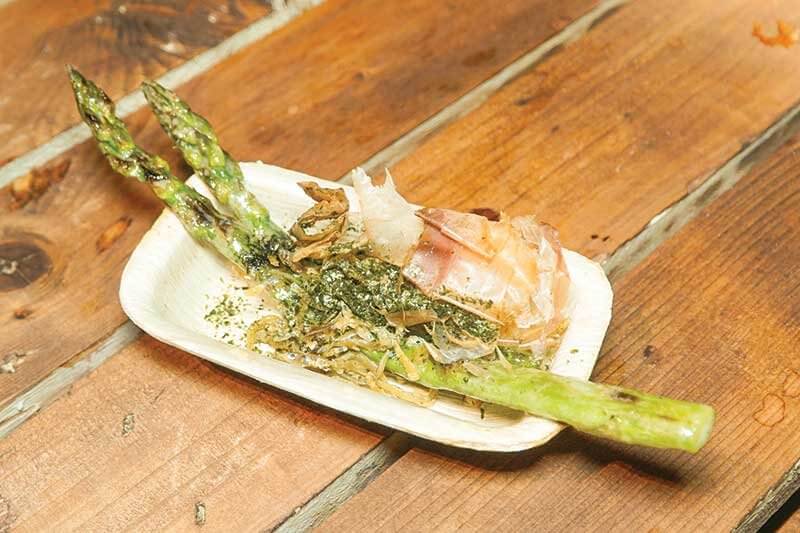 Gerry Ludwig
Gerry Ludwig Mangal-Charred Asparagus with Katsuobushi Butter from Lee Tiernan
While the majority of the presenting chefs were producing authentic renderings of the foods of their homelands, a few of the chefs were happily mashing up a variety of cuisines, creating unique and surprising flavor combinations along the way.
The cuisine of Shinobu Namae, chef/owner of restaurant L’Effervescence in Tokyo, is a purposeful combination of “Japanese terroir and European technique,” exemplified by his Beef Carpaccio, which he garnishes with wasabi, fish sauce, sake cream and a smoked mussel mayonnaise.
The husband and wife team of Greg Denton and Gabrielle Quiñónez Denton, chefs and owners of the new Bistro Agnes in Portland, Ore., creates cuisine that is Argentinian-inspired but made with local Oregon products. They wowed attendees with their Grilled Shiitake Mushrooms with Miso-Porcini Marshmallows and Sauternes Glaze.
Chef Andrew Hunter, a culinary development consultant based in Los Angeles, served a delicious mash-up of Uni Pasta with Harissa Yuzu Soy Butter that combined Italian, North African and Asian influences.
Val M. Cantu, chef/owner of Californios in San Francisco, gave his Wagyu Carne Asada a Euro twist with a sauce of black truffle mole.
Chef “JJ” Johnson prepared an Italian Arborio Rice Congee garnished with crispy pork and peri peri sauce.
David Hodson, chef de cuisine at Bouchon Bistro in Yountville, Calif., served an amazingly layered Merguez Sausage Banh Mi stuffed with country pâté, grapefruit supremes and fennel salad.
The ultimate show of culinary derring-do, however, was at the hands of Lee Tiernan, chef/founder of Black Axe Mangal in London, a 22-seat restaurant that has developed a cult-like following for cuisine that is a singular amalgam of nose-to-tail butchery and Turkish mangal grilling, with generous doses of Asian flavors thrown in.
Tiernan grabbed the crowd’s attention early with his Foie Gras Ice Cream, which he stuffed into an Amaretto Cherry Doughnut. He quickly followed that up with Crispy Smoked Pork Jowls tossed in Mission Chinese Chongqing Wing Spice, a potent blend of Sichuan peppercorn, cumin, fennel, star anise, clove and mushroom powder.
Tiernan’s Mangal-Charred Asparagus with Katsuobushi Butter was a study in umami, but the most delicious and surprising dish was his Ox Heart with Scallions, Chile and Ginger—the heart perfectly grilled to a tender medium rare, in a sauce both slightly sweet and slightly hot, whose depth and complexity belied its three-ingredient description.
Honoring the Past
In special recognition of the anniversary, a retrospective tasting event was held at the new CIA at Copia Center in Napa, Calif., highlighting memorable dishes that through the years have become culinary touchstones of the conference. And while most of the chefs who created the dishes could not be present to personally serve them, their presence was felt with each taste.
One exception was legendary chef Rick Bayless, who was on hand to prepare and serve his Tacos de Huitlacoche—freshly made tortillas filled with corn fungus simmered in a sauce of tomatoes, poblano chiles and epazote that, when first served at Worlds of Flavor in 1999, became a conference sensation.
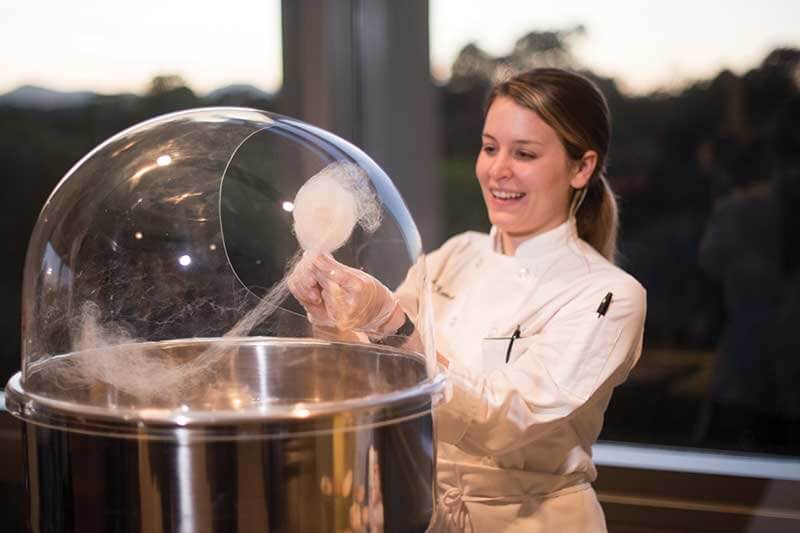
Chef José Andrés’ Cotton Candy Foie Gras was featured at the Retrospective Tasting Event, served here by CIA student Allison Komara.
Another showstopper was Cotton Candy Foie Gras, created by chef José Andrés for the 2006 conference, a skewered cube of foie gras torchon spun in a cotton-candy maker that resulted in an insanely delicious counterpoint of sweet and savory flavors.
The Blackjack Quesadilla, created by chef Roy Choi in 2009, evoked memories of both the dawn of the food-truck movement and the modern culinary mash-up. He served a Mexican/Korean flavor collision of spicy pork marinated in gochujang and Sprite, griddled within a flour tortilla with pepper Jack cheese, salsa verde and sesame seeds.
Choi’s innovative style paved the way for future mash-ups, including the Belly Dog, created by Chicago chef Bill Kim in 2013. It was recreated for the event: a chargrilled all-beef hot dog topped with pickled green papaya, curry mayonnaise and crispy egg noodles.
A dish that was the talk of the 2016 Worlds of Flavor provided a sweet finish to the evening: the Corn Husk Meringue from Enrique Olvera, chef/owner of Cosme. The signature dessert at his New York location, the meringue is flavored with toasted corn-husk powder, slowly baked into a delicate shell, and filled with a sweet-corn cream lightened with whipped mascarpone.
Culinary Reclamation
If any rising star emerged from the conference, it was Sean Sherman, founder/chef and CEO of The Sioux Chef, a group dedicated to revitalizing Native American cuisine. It is more than a bit ironic that the most American of cuisines—Native American—is almost completely absent from today’s dining scene. Sherman intends to change that, through the combined goals of: educating the public about the principles and techniques of Native American cooking; reclaiming indigenous American foodways by increasing awareness of the vast cooking ingredients available via foraging; establishing seed banks; and growing the number of indigenous food suppliers, of whom Sherman is a staunch supporter.
In both his presentation and cooking demonstrations, Sherman spoke of the “power of plant knowledge,” which his ancestors used to forage flavorful herbs and seasonings for their cooking, including wild bergamot, sage, cedar, juniper, sumac, mustard and rose hip.
He also noted that a large part of the rediscovery of his culinary heritage involved learning the Native American cooking techniques, such as drying and milling native vegetables, including pumpkin, yuca and sunchokes. Even cattails can be used to create baking flours, highlighted in his dish of Yuca and Agave Cake with Rose Hip Sauce and Acorn Powder.
Sherman also demonstrated the classic technique of drying meats and chopping them with berries to create pemmican, which he also called wasna, to create his dish of Dried Duck and Berry Wasna, served on a bed of puffed wild rice and amaranth.
Two other notable techniques converged in one dish: the first of slowly braising wild game with grains and squash, and the second of nixtamalizing corn—the practice of boiling the kernels in lime-treated water—which Sherman says maximizes the solubility of the vitamins in the corn. The resulting dish of Cedar Stewed Rabbit with Nixtamalized Blue Corn and Squash was a highlight of the conference: tender shreds of fragrant rabbit atop delicate corn kernels bathed in the reduced braising liquid, garnished with crispy shreds of carrot, carrot top and foraged wood sorrel leaves.
So, is it possible that the foods of this ancient and nearly lost culture could become a cuisine of the future? It’s fairly safe to say that its attributes—which include compelling flavors and textures, unique ingredients, freshness, sustainability and healthy nutritional profiles—match up well with the demands of today’s dining consumer.
The twentieth Worlds of Flavor Conference provided the opportunity to reflect on the exciting changes and innovation that have moved foodservice forward over the past two decades, and contemplate the changes to come. As global cuisines continue to exert their influence on American menus, whether highly authentic or playfully mashed-up, that world becomes just a bit smaller with each passing year.
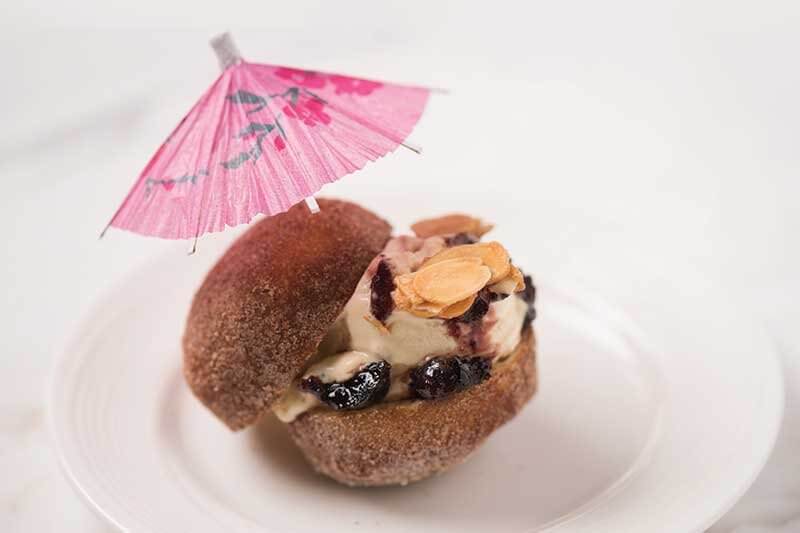 CIA Leadership Programs
CIA Leadership Programs Chef Lee Tiernan layered Foie Gras Ice Cream inside an Amaretto Cherry Doughnut for a stunning sweet-savory bite.

